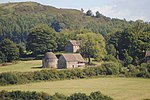
Cefn Mably House is a mansion situated in Cefn Mably, Caerphilly County Borough, Wales. It is a Grade II listed building. The gardens surrounding the house are listed on the Cadw/ICOMOS Register of Parks and Gardens of Special Historic Interest in Wales.

Ruperra Motte, also known as Craig Ruperra Motte, is a medieval motte and bailey castle in the community of Rudry close to the village of Draethen in the Caerphilly County Borough on the border with Newport in south west Wales. It is a Scheduled Monument within the Grade II listed Registered Historic Park & Garden, which also includes Ruperra Castle.

Rhondda Cynon Taf is a county borough in South Wales. It is located to the north-west of Cardiff and covers an area of 424 km2 (164 sq mi). In 2021 the population was approximately 237,500.

Powys is a county and preserved county in Wales. It covers an area of 5,180 km2 (2,000 sq mi) and in 2021 the population was approximately 133,600.

Merthyr Tydfil County Borough is located in the historic county of Glamorgan in Wales and takes its name from its largest town. The county borough covers an area of 111 km2 (43 sq mi) and had a population of approximately 58,900 in 2021. There are three sites on the register of parks and gardens in Merthyr Tydfil County Borough. Two are listed at Grade II*, and one is Grade II.

Monmouthshire is a county of Wales. It borders Torfaen and Newport to the west; Herefordshire and Gloucestershire to the east; and Powys to the north. The largest town is Abergavenny, with other large settlements being Chepstow, Monmouth, and Usk. The present county was formed under the Local Government (Wales) Act 1994, which came into effect in 1996. It has an area of 850 km2 (330 sq mi), with a population of 93,200 as of 2021. Monmouthshire comprises some sixty per cent of the historic county, and was known as Gwent between 1974 and 1996.

The Isle of Anglesey, a principal area off the north-west coast of Wales, includes the islands of Anglesey, Holy Island and some islets and skerries. It covers an area of 711 km2 (275 sq mi) and in 2021 the population was approximately 68,900.

Bridgend County Borough is a county borough in south-east Wales. It covers an area of 251 km2 (97 sq mi). In 2021 the population was approximately 145,800.

The Vale of Glamorgan is a county borough in south-east Wales. It covers an area of 331 km2 (128 sq mi) and in 2021 the population was approximately 132,500.

Neath Port Talbot is a county borough in South Wales. It covers an area of 441 km2 (170 sq mi) and in 2021 the population was approximately 141,900.

The City and County of Swansea is a principal area in south Wales. It covers an area of 380 km2 (150 sq mi) and in 2021 the population was approximately 237,800.

Carmarthenshire is a county in the south-west of Wales. It covers an area of 2,370 km2 (920 sq mi). In 2021 the population was approximately 188,200.

Pembrokeshire is a county in the south-west of Wales. It covers an area of 1,619 km2 (625 sq mi). In 2021 the population was approximately 123,700.

Ceredigion is a county in the west of Wales. It covers an area of 1,785 km2 (689 sq mi) and in 2021 the population was approximately 70,700.

Newport is a city and county borough in the south of Wales. It covers an area of 190 km2 (73 sq mi) and in 2021 the population was approximately 159,700.

Gwynedd is a county in the north-west of Wales. It covers an area of 2,535 km2 (979 sq mi) and in 2021 the population was approximately 117,100.

Conwy County Borough is a county borough in the north of Wales. It covers an area of 1,126 km2 (435 sq mi) and had a population of approximately 114,800 in 2021.

The Welsh National and Universal Mining Disaster Memorial Garden at Senghenydd, Caerphilly, commemorates the 439 men killed in the Senghenydd colliery disaster of 1913, the worst mining accident in British history; the 81 lives lost in an earlier pit explosion at Senghenydd in 1901; and acts as a national memorial to all of the dead of the 152 mining disasters that have occurred in Wales. The garden was opened in 2013, the centenary of the 1913 event. In March 2024 Cadw added the garden to its Cadw/ICOMOS Register of Parks and Gardens of Special Historic Interest in Wales. Its listing record describes the garden as "an important site of public commemoration and memory".
























